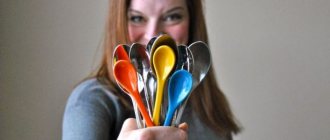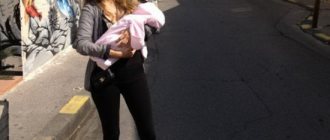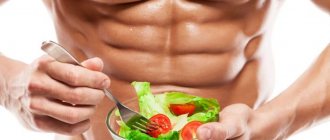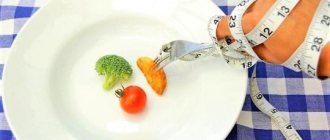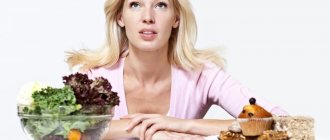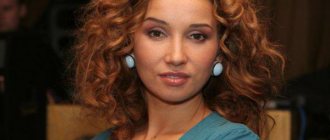Basic rules of diet after cholecystectomy
The goals of therapeutic nutrition after removal of the gallbladder are:
- creating maximum chemical sparing of the liver;
- improvement of bile separation;
- ensuring normal functioning of the liver, bile ducts and the entire gastrointestinal tract.
According to the order of the Ministry of Health of the Russian Federation No. 330, dietary nutrition after cholecystectomy in medical institutions corresponds to the main version of the standard diet (STD). According to Pevzner’s classification, the diet after removal of the gallbladder is treatment table No. 5.
Despite some restrictions in treatment table No. 5, the diet must be physiologically balanced, that is, contain the required amount of vitamins and minerals.
Daily nutrient content:
- proteins – 85-90g, of which 45-50g are animal proteins;
- fats – 70-80g, of which up to 25-30% are fats of vegetable origin;
- carbohydrates – 300-330g, with simple sugars – no more than 30-40g.
The daily calorie content of the treatment table after removal of the gallbladder is 2170-2400 kilocalories.
Basic principles of nutrition
- diet; Meals should be fractional: up to 4-6 times a day, in small portions. Although there is no gallbladder, the bile ducts are preserved, and, therefore, they must be emptied on time so that the bile does not stagnate in them. In addition, small portions of food do not burden the liver and other digestive organs, which avoids inflammation. It is especially important to eat at the same time: this normalizes the functioning of both the liver and bile ducts. Small portions of food prevent the development of obesity, which is of great importance.
- food processing; Food can be steamed, baked or boiled. Cooking food in the microwave should be avoided; multicookers and double boilers are not prohibited. Stewing foods is occasionally allowed. In the first 45 days after the operation, when cutting, the products are crushed and wiped. This type of culinary food processing provides maximum mechanical sparing of the liver and stomach, and also has a beneficial effect on the entire digestive tract.
- food temperature; Dishes are served only warm (15-60 degrees Celsius). Excessively hot and cold foods cause spasms of the bile ducts and irritate the stomach and duodenum.
- salt and liquid; The consumption of sodium chloride corresponds to the physiological norm (8-10 grams per day). Avoid salty foods that irritate the gastrointestinal tract and cause stagnation of fluid, and therefore bile, in the body. Liquids should be consumed up to 2 liters per day. 30 minutes before meals, it is recommended to drink 1 glass of alkaline mineral water without gas, which stimulates the flow of bile.
- alcohol; You will have to stop drinking alcohol (with rare exceptions). Ethyl alcohol causes spasms of smooth muscles and increases the tone of the biliary tract. In addition, in the absence of a gallbladder, the liver alone breaks down alcohol, and the load on it increases. Systematic consumption of alcoholic beverages is dangerous not only by the return of previous problems with the gallbladder, but also by the development of cirrhosis of the liver.
- We eat deliciously. Each meal should be beautifully arranged: at a table covered with a tablecloth, with flowers, in a calm atmosphere. It is necessary to eat slowly, chewing each piece thoroughly. This will allow you to be satisfied with very moderate portions, which will have a beneficial effect on weight and ensure minimal stress on the gastrointestinal tract.
Tell us more about these violations
The formation and excretion of bile occurs in new anatomical conditions. Adaptation to them in case of a successful operation takes about a year.
But often after surgery, pre-existing diseases (duodenitis, ulcers, reflux esophagitis, irritable bowel syndrome) and chronic biliary pancreatitis - a condition of the pancreas that suffers most from the presence of stones and dysfunction in the gallbladder - become aggravated.
Due to the loss of the cystic reservoir, bile produced by the liver in large quantities (up to 1.5 liters per day) immediately enters the ducts. The pressure in them increases, inflammation occurs, and with it pain and dyspepsia (diarrhea). In addition, the tone of the sphincter of Oddi, a smooth circular muscle that controls the flow of bile into the duodenum, is pathologically increased. In a word, consider chronic pancreatitis, and with it - a violation of the enzymatic activity of the pancreas, food digestion and metabolism.
Prohibited Products
First of all, it is necessary to exclude foods with high cholesterol content from the diet after removal of the gallbladder. It is this that causes thickening and stagnation of bile and promotes stone formation.
Secondly, since the bile after removal of the bladder does not contain most of the enzymes that break down fats, the consumption of animal (refractory) fats should be limited.
You should also avoid products that increase bile formation and secretion of gastric and duodenal juices (extractives, spicy foods, marinades, etc.). It is contraindicated to eat foods that linger in the intestines for a long time, causing rotting and fermentation, stimulating gas formation.
The consumption of simple carbohydrates must also be limited: they are easily broken down, increasing the level of “bad” cholesterol, and are stored in the form of fatty layers.
The list of prohibited products includes:
- bread made from premium flour, all pastries and fried dough products (pancakes, pancakes, pies, as well as cakes and pastries);
- cooking oil, margarine, any lard:
- rich broths and soups made from them (meat, fish, poultry);
- fatty meats and poultry (goose, duck, pork, lamb), stringy meat;
- fatty fish (mackerel, sturgeon, catfish, burbot, salmon);
- canned meat and fish;
- all sausages;
- liver (kidneys, liver, brains);
- fish caviar;
- sour and bitter vegetables (radishes, radishes, green onions, spinach, sorrel, daikon);
- fried eggs, egg yolks;
- marinades and pickles;
- smoked meats;
- spices: pepper, mustard, horseradish, vinegar, coriander and others;
- sour berries and fruits;
- ice cream, chocolate, cream products;
- strong tea, coffee, cocoa, sweet carbonated drinks, sparkling mineral waters;
- legumes;
- dishes from public food outlets (pizzas, hamburgers).
What is bad if the gallbladder is removed to rid the body of gallstones?
Of course, getting rid of gallstone disease in the simplest way is the dream of both the patient and the gastroenterologist. But at the same time, it is necessary to provide for all possible consequences of such a step.
After all, even at the stage of preparation for the operation and during its implementation, there is a danger of underestimating many factors. These are diagnostic errors when softer clots of bile - sludge - are mistaken for stones, and removal of the gallbladder without stones at all inevitably entails complications.
The possibility of damage to the bile ducts, which sometimes does not even depend on the skill of the surgeon, may require repeated surgery and long-term rehabilitation. In addition, undetected stones can remain in the ducts and cause acute cholangitis (inflammation of the ducts) and obstructive jaundice.
The bile produced by the liver enters the gallbladder, where it is concentrated, and from there it flows into the duodenum, participating in the digestion of fats and food proteins. Deprived as a result of cholecystectomy - an operation to eliminate the natural storage of bile (gallbladder) with stones - the regularity of bile movement is disrupted. And now bile is involved not only in digestion, but can be thrown into the stomach, burning the mucous membrane, threatening gastritis, esophagitis, and biliary diarrhea.
Anatomical changes are followed by biochemical ones. And functional disruptions of the gastrointestinal tract are the most common.
Authorized Products
Dishes that are recommended to be consumed by a person who has undergone cholecystectomy should not be irritating or unnecessarily stimulate the gastrointestinal tract.
When preparing food, it is necessary to use products that are rich in pectins and lipotropic substances. Lipotropic substances break down cholesterol, prevent its deposition on the walls of blood vessels (atherosclerosis) and accumulation in the bile, which causes its thickening. Pectins, in turn, gently envelop the mucous membranes of the digestive tract, prevent the absorption of harmful substances, stimulate intestinal motor function and have a healing effect.
In addition, the patient's medical diet after removal of the gallbladder should include large quantities of plant fiber. It not only contains vitamins, but also stimulates intestinal motility, preventing flatulence, constipation and retention of food masses in it.
We should not forget about fermented milk products, because they are sources of valuable animal protein and calcium, and contain live bacteria that have a beneficial effect on the intestinal microflora.
The list of permitted products includes:
- yesterday's bread or dried bread, crackers, biscuits, crackers;
- soups with secondary broths, soups with vegetable broth;
- lean meats and poultry (turkey, chicken, veal, rabbit, beef);
- unsalted and low-fat ham;
- porridges, both crumbly and semi-viscous (buckwheat, oatmeal);
- all seafood as a source of iodine, neutralizing cholesterol;
- low-fat fish (pike, trout, salmon) as a source of polyunsaturated fatty acids;
- steamed egg white omelette;
- vegetable oils, butter for dishes;
- cottage cheese, kefir, yogurt, “live” yogurt, unsalted and low-fat cheeses;
- fruits and berries (very sweet and sour in processed form: jellies, mousses, jellies, compotes);
- jam, marmalade, chalk;
- fresh herbs, tomatoes, cucumbers, sweet peppers, pumpkin, beets, zucchini, potatoes, carrots;
- tea with milk or lemon, weak coffee, alkaline mineral waters, juices and fruit drinks;
- lightly salted salmon, jellied fish, vinaigrette, soaked herring, fresh vegetable salads.
How to live without a gallbladder, is physical activity possible?
A month and a half after the operation, it’s time to start exercising. It is best to start with walking; 30-40 minutes of walking in the fresh air prevents bile stagnation and improves oxygen saturation of the body. And after a few days you can do light exercises. After 2-3 minutes of walking, perform the exercises in a lying or standing position, repeating 4-6 times.
- Lying on your back, legs straight, arms along the body. As you exhale, bend your leg, bringing it as close to your stomach as possible, and while inhaling, straighten it. Also with the other foot.
- Lying on your back, hands on your belt, as you exhale, lift and move your straight leg to the side, while inhaling, lower it. Also with the other foot.
- Lying on your back, legs bent, arms along your body. As you inhale, slide your heels along the floor, slowly stretch your legs, and as you exhale, bend them just as slowly.
- Lying on your side, legs straight, one hand on your belt, the other behind your head. As you exhale, bend the leg lying on top, and while inhaling, straighten it. Do the same by turning to the other side.
- Standing, feet shoulder-width apart, hands to shoulders, make circular movements with your elbows 8-10 times forward and back. Breathing is voluntary.
- Standing, feet shoulder-width apart, hands on your belt. As you inhale, move your elbows back, and as you exhale, return to the starting position. 6-8 times. Or turn your body left and right, spreading your arms to the sides.
Bends, lifting the legs and body from a lying position, and other abdominal exercises are allowed no earlier than six months after the operation and if you are in good health. And heavy physical activity, especially associated with tension in the abdominal muscles, can be done only after a year in order to avoid the formation of a postoperative hernia.
Ask questions about the article in the comments; if you want to contact me personally and confidentially, click the “Ask a Question” button at the top. Initial consultation is free.
Health to you, dear readers!
